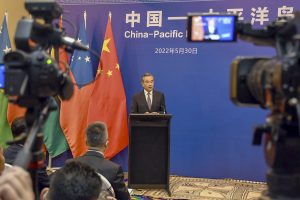In April 2022, Solomon Islands and China signed a security deal that, according to a leaked draft, read in part: “Solomon Islands may, according to its own needs, request China to send police, armed police, military personnel and other law enforcement and armed forces to Solomon Islands to assist in maintaining social order” and “China may, according to its own needs and with the consent of Solomon Islands, make ship visits to, carry out logistical replenishments in, and have stopover and transition in Solomon Islands, and the relevant forces of China can be used to protect the safety of Chinese personnel and major projects in Solomon Islands.”
The collective response from the global strategic community was essentially the one expressed in an internal email from Ryan Washburn, USAID mission director to the Philippines, the Pacific Islands, and Mongolia, to colleagues: “Yikes!”
It wasn’t that China’s strategic ambitions in the Pacific Islands were a surprise; it was that they now could no longer be ignored or explained away.
In capitals all over the world, bureaucrats who had the Pacific Islands as one of their many files (the Philippines, the Pacific Islands, and Mongolia?), where it often languished near the bottom of the pile, were suddenly called into the boss’ office to answer the question: “What are we going to do about it?”
The Solomon Islands security deal was only the start for Beijing. Chinese Foreign Minister Wang Yi and a large delegation also made an eight-country tour through the Pacific Islands, just after the Australian election and the Quad leaders meeting. They floated a “China-Pacific Island Countries Common Development Vision,” supported by a “China-Pacific Island Countries Five-Year Action Plan on Common Development (2022-2026).”
Those deals weren’t signed, but it’s unlikely Beijing thought they would be. The largely virtual meeting discussing the deals with 10 Pacific Island countries (PICs) was held in the middle of Wang’s trip. Had he been serious about seeing the documents signed, it would have been held at the end, after he had met as many leaders as possible in person.
What Wang did get out of circulating the deals was the chance to identify supporters and opponents of Chinese plans – allowing China to refine its already very extensive political warfare operations in the region.
At the same time, in each of the Pacific Island countries Wang visited, he achieved a range of goals, including signing other deals that, at China’s request, remain secret; muzzling the local press; and blithely ignoring national quarantine restrictions that have for two years kept local families apart – all indications of Chinese influence at the national level.
This also made it clear in those already nervous capitals that China’s plans extended well beyond Solomon Islands, and their responses would have to be similarly far-reaching if they wanted to give the PICs real options.
One of the major initiatives – Partners in the Blue Pacific – was mentioned by Campbell at a June 23 event at the Center for Strategic and International Studies (CSIS) in Washington, D.C. We’ll get to that. But first, what do those coveted partners, the people of the Pacific Island countries, think about all this?

































